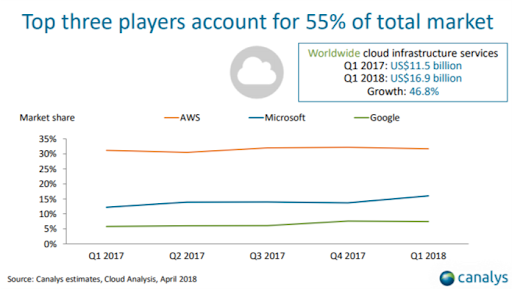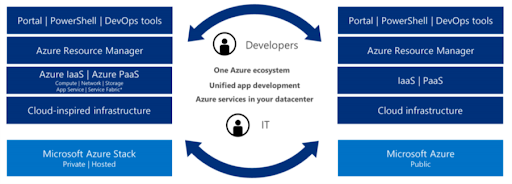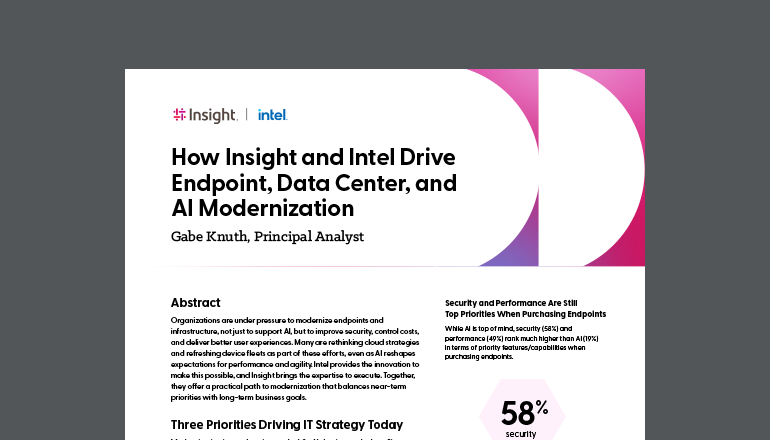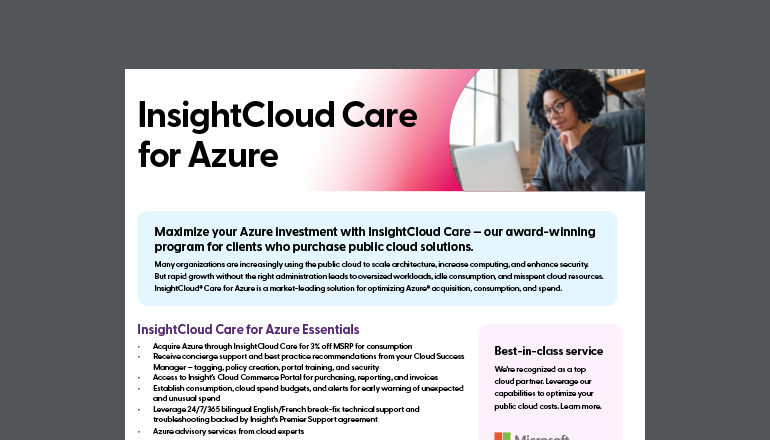Article Microsoft Azure vs. Amazon AWS: Which One is Best for My Business?
By Insight Editor / 21 Sep 2018 / Topics: Cloud Software Microsoft Azure

If you’re a large-sized business or enterprise company and are at the stage of looking at the cloud as your next-step, then you should be familiar with Azure and AWS.
These are the cloud platform offerings of Microsoft and Amazon, respectively.
In fact, it’s these two players who are dominating the cloud infrastructure market. In Q1 2018, Amazon held over 30% of cloud market share, with Microsoft following with over 15%. On the margins is Google Cloud Platform (GCP) at around 5% (Canalys).
Amazon, Microsoft & Google Lead the Cloud Market

According to Canalys, the top three players command about 55% of the overall cloud market.
However, it’s also clear that the race is being steered by Amazon and Microsoft, who collectively have more than 45% of all current cloud users. Out of these two leaders, which one is best for your business?
Microsoft Azure vs. Amazon Web Services (AWS)
To be frank, Azure and AWS each cover the essentials really well — i.e. cloud storage, analytics, dedicated networking, machine learning, etc. Microsoft has an excellent map outlining exactly how each of its Azure offerings match with those of Amazon.
If we just look at the services in of themselves, then both are excellent. After all, the market has awarded nearly half of itself to these two companies for a reason. That’s evident.
That said, the interesting thing in all this is Azure’s market share growth.
Azure launched in 2010, a full four years after AWS. Simply matching AWS feature-to-feature isn’t enough to capture second-place in the market, especially as a new entrant. Moreover, the recent data shows that Azure is catching ground while AWS’ share shrinks (albeit, slightly).
How is Azure Growing?
Microsoft Azure is growing because it, besides offering the same features as AWS, provides large businesses and enterprises with the benefit of re-leveraging their existing IT infrastructure.
In other words, using Azure doesn’t require you to invest in a fresh slate of expertise and tools, nor does it force you to write-off any significant investment in your on-premise IT.
Thus, you can benefit from the cloud today, but by using the knowledge you already have and by augmenting your on-premise IT, not by undermining it. In other words, hybrid cloud.
Microsoft Azure Hybrid Cloud
Azure is growing rapidly because of its hybrid cloud solutions.
Basically, Azure equips companies with mature IT infrastructure and processes to use the cloud in concert with their existing systems.
For example, Boeing used its on-premises SQL Server database in combination with Azure, but with Azure handling the heavy data processing and analysis work (Ars Technica).
The amazing thing about this hybrid configuration is that it achieves four goals:
First, it let Boeing enhance the effectiveness of its existing in-house IT system (SQL Server) by off-loading heavy tasks to Azure. The limits of Boeing’s on-premises IT isn’t a bottleneck now.
Second, security. Boeing used what it calls the “shred and scatter” method. Basically, it had split the data across many Azure nodes, which would then handle the heavy calculation work.
Even if a hacker gained access to this data, they wouldn’t know what to make of it because the data will be incomprehensible. The data is also encrypted.
Third, the application using this data processing is 10 years old and was developed using .NET and Visual Basic. This made rewriting the app for the cloud easier as Azure can work with some of that technology (e.g. Microsoft has tools for migrating .NET to Azure App Service).
Fourth, development freedom. The rewritten version of the app uses Azure in combination with third-party technologies (e.g. the platform to run .NET code on-premises).
Microsoft Azure: Advantages and Disadvantages for Businesses
At its core Microsoft Azure lets large businesses and enterprises extend the value of existing IT investments while also having the freedom to leverage modern capabilities.
Returning to Boeing, it’s clear that Azure offers the benefit of choice. You can decide how to configure your IT system. For example, we can see Boeing combine legacy Microsoft systems with Azure as well as third-party, non-Microsoft services.
In 2016, Boeing affirmed its trust in Microsoft by committing its entire cloud strategy to Azure.
According to the Wall Street Journal, Boeing will have completed transitioning all of its apps to Azure by 2018. Interestingly, GE — which manufactures turbofan engines for Boeing’s aircraft — opted in July 2018 to move its Predix IT platform to Azure (Microsoft).
It’s evident that enterprises are recognizing Azure’s value in enabling hybrid deployments, be it with existing systems and infrastructure, third-party technologies and/or with private cloud.
Indeed, it wouldn’t be fair to limit hybrid cloud to just making old systems work with the cloud (but it’s a major factor). Some businesses could need their cloud deployments augmented by new in-house data centers (private cloud), with the latter managing the most sensitive data.
Microsoft built tools to enable for interoperability between Azure and your private cloud system.

If you’re in a comparable situation, then considering Azure would be a good decision, especially when you have industry leaders such as Boeing and GE on-track to deploy Azure.
In terms of disadvantages. Seeing how the top cloud service providers are similar, you shouldn’t go wrong by selecting one of the top competitors (e.g. Azure, AWS or GCP).
That said, you might be leaving money on the table by not exploring how Azure could work with what you have. Moreover, if you have data storage that needs that necessitate some element of private cloud hosting on-premises, then Azure helps make interoperability an easier process.
Is Microsoft Azure Right for Your Business?
The value of Azure to business’ with large, long-established IT infrastructure is clear. In fact, if you have a mature IT system already in place, then Azure should be your first consideration.
It isn’t only an issue of reusing your business’ existing IT infrastructure and expertise (e.g. your Microsoft certified developers and administrators), but mitigating risk as well.
Cloud Deployment Options (Cost vs. Time)

By using an Azure-based hybrid cloud deployment, you could also begin slowly phasing your IT to the cloud. This keeps disruptions to your operations to a minimum while ensuring that your IT advances to meet your medium and long-term needs. It’s also cost-effective.




